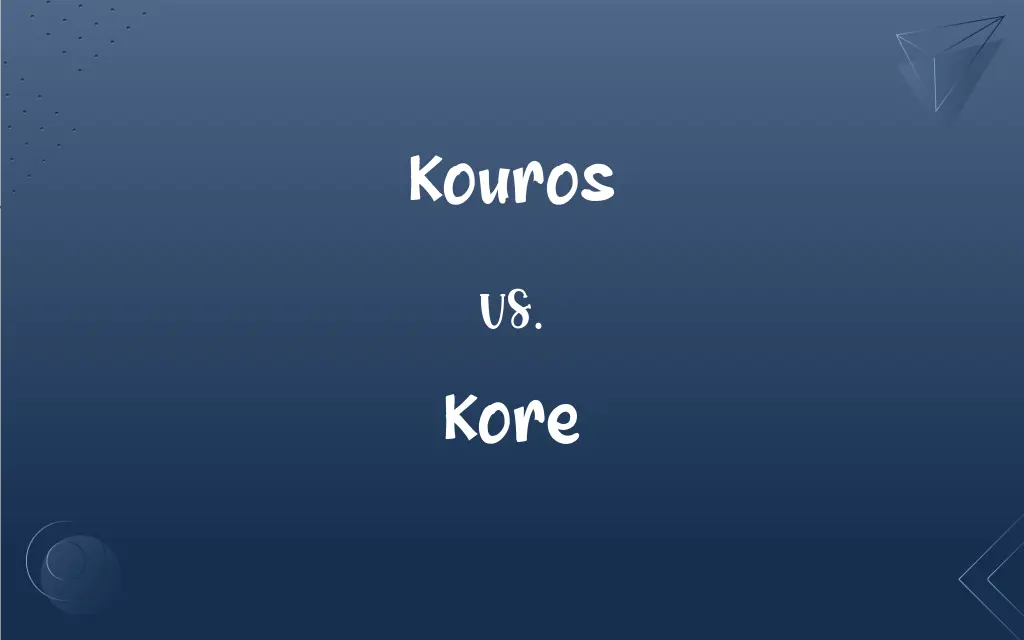Kouros vs. Kore: What's the Difference?
By Janet White & Aimie Carlson || Updated on May 22, 2024
Kouros refers to ancient Greek statues of young men, whereas Kore represents statues of young women, both embodying idealized youth and beauty.

Key Differences
Kouros refers to statues of young men from ancient Greece, typically nude and standing in a forward-facing, rigid posture. These statues were created during the Archaic period (circa 650-480 BCE) and were often used as grave markers or offerings to gods. Kore, on the other hand, refers to statues of young women from the same period. Unlike kouroi, korai (plural of kore) are depicted clothed in elaborate drapery and often adorned with intricate hairstyles and accessories.
While kouroi are characterized by their nudity and rigid, forward-facing stance, korai are known for their detailed clothing and more relaxed, yet still formal, posture. Conversely, korai showcase the elegance and decorum of young women, with their garments often painted in bright colors to enhance their lifelike appearance.
Both kouros and kore statues were influential in the development of Greek sculpture, leading to more naturalistic representations in later periods. Despite their differences, both types of statues share a common purpose: to embody and immortalize the ideals of youth and beauty in ancient Greek culture.
Comparison Chart
Subject
Young men
Young women
Attire
Nude
Clothed
ADVERTISEMENT
Purpose
Grave markers, offerings
Grave markers, offerings
Posture
Rigid, forward-facing
Relaxed, yet formal
Emphasis
Athleticism, strength
Modesty, grace
Time Period
Archaic period (circa 650-480 BCE)
Archaic period (circa 650-480 BCE)
Gender Representation
Male
Female
ADVERTISEMENT
Cultural Significance
Ideal male virtues
Ideal female virtues
Kouros and Kore Definitions
Kouros
Often used as grave markers or offerings to gods.
This kouros was found at an ancient burial site.
Kore
Created during the Archaic period of Greek art.
Korai were commonly produced around the 7th century BCE.
Kouros
Ancient Greek statue of a young man, typically nude.
The museum's kouros statue stands tall and proud.
Kore
Represents idealized female youth and beauty.
The kore statue highlights grace and modesty.
Kouros
Represents idealized male youth and beauty.
The kouros symbolizes strength and athleticism.
Kore
Characterized by detailed clothing and a relaxed posture.
The kore's garment is beautifully sculpted and painted.
Kouros
Created during the Archaic period of Greek art.
Many kouroi date back to the 6th century BCE.
Kore
Often used as votive offerings or grave markers.
This kore was dedicated at a temple site.
Kouros
Characterized by a rigid, forward-facing posture.
The kouros maintains a formal and upright stance.
Kore
Ancient Greek statue of a young woman, typically clothed.
The kore in the exhibit is dressed in intricate drapery.
Kouros
A sculpture representing a standing nude young man, especially one produced in Greece before the fifth century BC.
Kore
A sculpture representing a standing young woman clothed in long robes, especially one produced in Greece before the fifth century BC.
Kouros
A sculpture of a naked youth in Ancient Greece, the male equivalent of a kore.
Kore
An Ancient Greek statue of a woman, portrayed standing, usually clothed, painted in bright colours and having an elaborate hairstyle.
Kore
(Greek mythology) daughter of Zeus and Demeter; made queen of the underworld by Pluto in ancient mythology; identified with Roman Proserpina
FAQs
What was the primary purpose of korai?
Korai served similar purposes, such as votive offerings and grave markers.
What was the primary purpose of kouroi?
Kouroi were often used as grave markers or offerings to gods.
What is a kouros?
A kouros is an ancient Greek statue of a young man, typically nude and standing in a rigid posture.
What is a kore?
A kore is an ancient Greek statue of a young woman, usually clothed in elaborate drapery.
What period do kouroi and korai come from?
Both types of statues originate from the Archaic period of Greek art, around 650-480 BCE.
How are korai typically depicted?
Korai are depicted clothed, with detailed garments and a more relaxed posture.
What ideals do korai represent?
Korai represent ideals of female youth, grace, and modesty.
Were korai painted?
Yes, korai were often painted in bright colors to highlight their detailed clothing.
Are kouroi and korai gender-specific?
Yes, kouroi depict males, and korai depict females.
What is the plural of kouros?
The plural of kouros is kouroi.
What is the plural of kore?
The plural of kore is korai.
Were kouroi painted?
Yes, many kouroi were originally painted to enhance their lifelike appearance.
How are kouroi typically depicted?
Kouroi are depicted nude, with a rigid, forward-facing stance.
What ideals do kouroi represent?
Kouroi represent ideals of male youth, athleticism, and strength.
What materials were used for kouroi and korai?
Both types of statues were commonly made from marble.
Do kouroi and korai appear in the same locations?
Yes, both types of statues were found in similar contexts, such as temples and graves.
What is a significant difference between kouroi and korai?
The significant difference is that kouroi depict young men and are typically nude, while korai depict young women and are clothed.
Do kouroi and korai have similar postures?
No, kouroi have a rigid, formal stance, while korai have a more relaxed, yet still formal, posture.
Are korai usually clothed?
Yes, korai are depicted clothed in elaborate drapery.
Are kouroi usually clothed?
No, kouroi are typically depicted nude.
About Author
Written by
Janet WhiteJanet White has been an esteemed writer and blogger for Difference Wiki. Holding a Master's degree in Science and Medical Journalism from the prestigious Boston University, she has consistently demonstrated her expertise and passion for her field. When she's not immersed in her work, Janet relishes her time exercising, delving into a good book, and cherishing moments with friends and family.
Co-written by
Aimie CarlsonAimie Carlson, holding a master's degree in English literature, is a fervent English language enthusiast. She lends her writing talents to Difference Wiki, a prominent website that specializes in comparisons, offering readers insightful analyses that both captivate and inform.































































